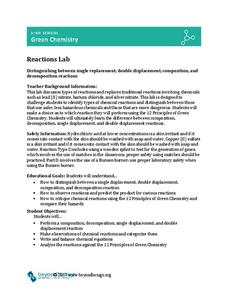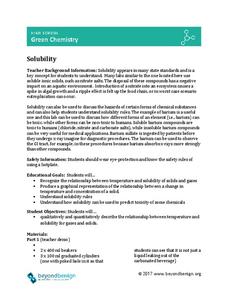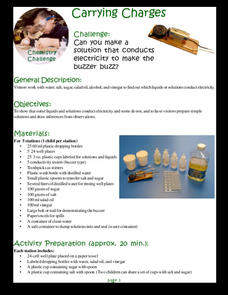Overcoming Obstacles
Finding Solutions
Middle schoolers apply all they have learned in the Problem Solving module by participating in a contest to see which group can build the tallest tower using only sheets of paper and masking tape.
Overcoming Obstacles
Identifying Options
"What should I do?" "How should I do it?" Middle Schoolers learn that answering these two questions is the key to solving problems. They begin with the first two steps of the Decision Making Process (gathering information and identifying...
Beyond Benign
Reactions Lab
You're bound to get a reaction from your classes with this experiment! Scholars perform several chemical reactions, make observations, and classify the reactions as single replacement, double replacement, composition, or decomposition...
Beyond Benign
Solubility
Enhance your class' ability to understand solubility. Science scholars examine how temperature and concentration affect solubility using an interesting lab experiment. The introduction and procedure also discuss the relationship between...
Bonneville
Design and Engineer Solutions
What's the best way to collect all that trash? A culminating activity has scholars use the knowledge and skills from the unit to design a solution to the plastic trash island problem. They use 3-D pens or a 3-D printer to build models of...
NASA
Mineral Mystery Experiment
One way to study something is to try to replicate it. Young scientists do just that as they use solutions to recreate mineral structures on a dwarf planet. They make solutions with different types of salt, evaporate them, and observe the...
Flipped Math
Calculus AB/BC - Unit 7 Review: Differential Equations
Differentiate everyone's knowledge. Pupils work through nine review questions to highlight key concepts from Unit 7. Items range from finding slope fields and reasoning with them to finding general and particular solutions of...
Flipped Math
Calculus AB/BC - Particular Solutions using Initial Conditions and Separation of Variables
Take the next step in separating. Pupils pick up from the previous lesson to now find the particular solution of a differential equation at a given point. Scholars watch three examples of finding the particular solution and hear the...
Flipped Math
Calculus AB/BC - General Solutions Using Separation of Variables
Viewers to learn how to solve a differential equation written implicitly. Pupils find out that they must first separate the variables to take the integral of each side before solving for y to arrive at a general solution for the...
Flipped Math
Calculus AB/BC - Reasoning Using Slope Fields
Find a solution in the field. An informative video presentation shows pupils how to use the information from a slope field to sketch the graph of a particular solution to a differential equation. Individuals learn how to determine the...
Flipped Math
Calculus AB/BC - Verifying Solutions for Differential Equations
Find out if it is truly the solution. An informative presentation provides viewers with multiple examples of finding the particular solution to a differential equation. Learners find out how to verify the solution by differentiating the...
American Chemical Society
Using Dissolving to Identify Substances
It's time to test observation and dissolving skills! After investigating the process of dissolving in previous lessons, pupils see if they can use their dissolving skills to identify substances. They dissolve known and unknown substances...
Flipped Math
True False Equations
Determine what makes the equation true. Learners view an instruction video on determining what values make an algebraic equation true. The pupils describe the solution set using three different methods: verbally, set notation, and...
American Chemical Society
Dissolving M-and-Ms
Learning ... how sweet it is! A hands-on lesson uses colored candies to demonstrate how positive and negative charges interact. Pupils use different types of liquids and watch as the color from the candies spreads—or doesn't.
American Chemical Society
Conservation of Mass
It may take up less space, but the mass stays the same. Tackle a common misconception about conservation of mass using a hands-on lesson. Learners measure the mass of substances before and after melting, dissolving, and undergoing a...
American Chemical Society
Dissolving and Back Again
From solid to liquid and then back again. Young scientists dissolve salt in water and then evaporate the water while observing what happens to the solute. They use their observations to make predictions about other solutions.
American Chemical Society
Dissolving an M&M
Here's a sweet lesson plan to explore solutes and solvents. Using candies and water, learners observe properties of parts of the solution as the candies dissolve. They then modify the setup and note variations in the solution.
Utah Education Network (UEN)
Decision Making
Making decisions, while maybe scary, is a skill that can be learned. Introduce teens to a five-step decision-making process that makes what may seem overwhelming possible. Pupils learn the steps and practice them by playing games,...
Missouri Department of Elementary
Opportunity Knocks, But It Costs, Too!
Sixth graders practice six steps to effective problem solving. Working with the school counselor, class members are presented with a scenario that requires them to make a decision. Individuals then write a reflection in which they...
Sciencenter
Carrying Charges
What's all the buzz about electricity? Scholars take part in a scientific activity to test the conductivity of liquids and solutions. They first see if water, salad oil, alcohol, and vinegar cause a buzzer to buzz when electrodes are...
New York City Department of Education
Dance and Text
Use texts and dances to teach inequalities and equations. A sixth-grade unit covers using variables in equations and inequalities to solve problems. Learners show what they know at the end of the unit using two performance tasks, one...
Discovery Education
By All Indications
How do people determine if something is acidic or basic? Learners make their own acid-base indicators using red cabbage and then determine the acidity and alkalinity of different substances. First, they test substances of known pH and...
Utah Education Network (UEN)
Utah Open Textbook: Chemistry
Technology can help save money and add convenience. The resource offers a free textbook for a complete Chemistry course. The text begins with a review of the scientific method and continues to explain topics such as chemical bonding,...
Concord Consortium
Sine Solution
How many times can eager mathematicians catch the waves? Pupils find the solutions of three different trigonometric equations. They then determine the effect of the slope of a line that intersects a trigonometric function and the number...

























